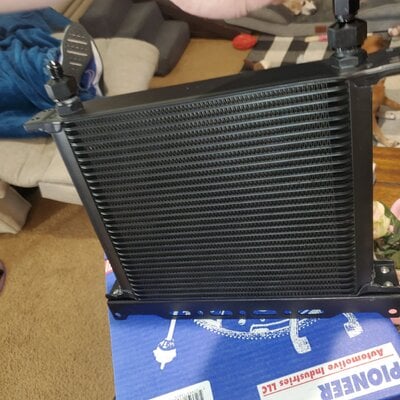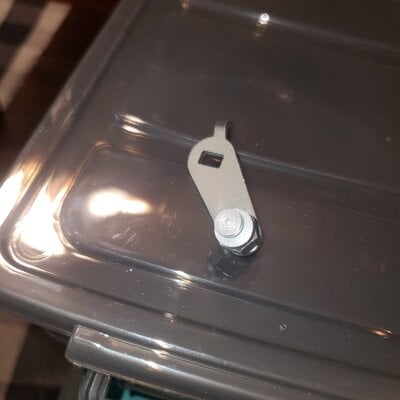Let's see so far today aux transmission cooler to run in series with radiator for the 200r4. An uber expensive TV cable arm to mod my 70 qjet to run the trans came in. Now i need some ideas from you guys on where to install sensor for trans temp gauge.
What did you buy for your Gbody today? (2025)
- Thread starter RICKDIZZLE
- Start date
You are using an out of date browser. It may not display this or other websites correctly.
You should upgrade or use an alternative browser.
You should upgrade or use an alternative browser.
The pan, period. Not in a cooler line, not the test port. The pan. Test ports don't get enough flow for accurate readings, especially if the conditions are changing quickly, like when you drive hard. An outgoing transmission line will have fluid at temps that'll make you cry due to being heated in the torque converter. Think 400+°... It's the hottest operating part of a transmission. You can put a sensor here to see how hot it gets, but that's not how hot the actual transmission is, nor is it the temp of the fluid feeding it. Some say it's like having an engine temp sensor in the cylinder heads- the hottest area of the engine- but it's not the same in my opinion.Now i need some ideas from you guys on where to install sensor for trans temp gauge.
A sensor on the return line tells you the temp "post cooler" but teeing into that won't get the most accurate, useful info either. The fluid will continue to cool once it enters the pan and joins all the other fluid that's touching surfaces, dissipating the heat. The information you need is at that location: in the transmission pan. Hopefully it's an extra deep, finned pan that drastically helps keep the temps down.
Sensor bung: you can drill a hole and weld a nut on for cheap, or there are bolt together kits that utilize an anaerobic sealer (dries in absence of air). There are weld-in bung kits as well. I don't know if you have a cast aluminum pan but they're so thick that some people have simply tapped them and threaded the sensor in- don't do that. There's not enough meat there for a solid, long lasting connection.
The short version is this: The outgoing transmission fluid temp is not anywhere near an accurate representation of transmission temperature or slippage, and you'll never know if you reach temps high enough to scorch it. You'll ONLY know how hot your converter gets. The cooled fluid line doesn't tell you the temp of the trans but you'll know if the fluid is getting cool enough. Kind of. A sensor in the pan tells you the temp of the fluid you're using and will alert you if your clutches are slipping and heating it up. It also tells you if you've cooled it enough to use. Knowing that information means the converter is happy unless there's a completely different issue.
I appreciate the detailed reply! What you said confirms what i was thinking. But never have run one what do i know. So thank you!. Right now it's the stock pan. Is it worth it to spend the 300+ for a deeper pan or will welding in a bung to the stocker be fine. Keep in mind not gonna be a racer just want to do the best i can before i fill it up with ATF. If i need to I'll drop the coin. But is it necessary?
it's one of those questions that only ourselves can answer.it's like anything else,if you're willing to $pend the money/do the leg work because you REALLY want to keep an eye on the trans temp,you have your answer.the worst thing that can happen is you install a gauge and spend a lot of time staring at it and over thinking the results. if you were running a spragless converter/transbrake and have poured $$$$ into the unit then i'd say it's an investment as those thing's bring heat...i think for most of us investing in a good cooler(like yourself)is plenty.I appreciate the detailed reply! What you said confirms what i was thinking. But never have run one what do i know. So thank you!. Right now it's the stock pan. Is it worth it to spend the 300+ for a deeper pan or will welding in a bung to the stocker be fine. Keep in mind not gonna be a racer just want to do the best i can before i fill it up with ATF. If i need to I'll drop the coin. But is it necessary?
They are gone.Also interested if available. Just took apart front suspension and planning to go with either blazer drop spindles or standard gbody…haven’t decided which path to take
I put mine in the pan. That is where the temp actually matters.Let's see so far today aux transmission cooler to run in series with radiator for the 200r4. An uber expensive TV cable arm to mod my 70 qjet to run the trans came in. Now i need some ideas from you guys on where to install sensor for trans temp gauge.

Your right I've been known to over think things and go down a rabbit hole confusing myself even more than i need to lol. I'm gonna run with stock pan and woth temp gauge installed and take it from there. Probably will be fine and can use the $$ on a set of tires now thats it's almost ready to move on its own after so many years
Right on time! I was finishing up breakfast and about to head into the garage to figure out a location for it.. thanks for the pic!
I just drilled a hole in the pan and welded an 1/8" NPT bung for the sender.
Similar threads
- Replies
- 256
- Views
- 12K
- Replies
- 385
- Views
- 19K
- Replies
- 6
- Views
- 622
- Replies
- 17
- Views
- 2K
GBodyForum is a participant in the Amazon Services LLC Associates Program, an affiliate advertising program designed to provide a means for sites to earn advertising fees by advertising and linking to amazon.com. Amazon, the Amazon logo, AmazonSupply, and the AmazonSupply logo are trademarks of Amazon.com, Inc. or its affiliates.



